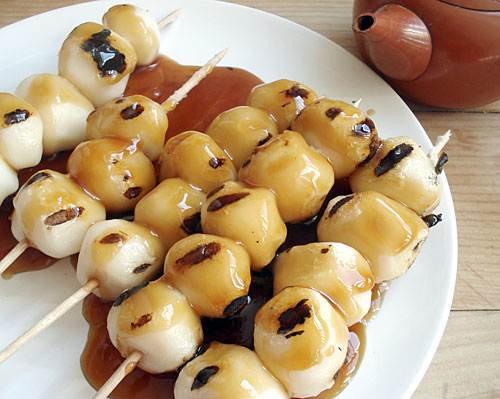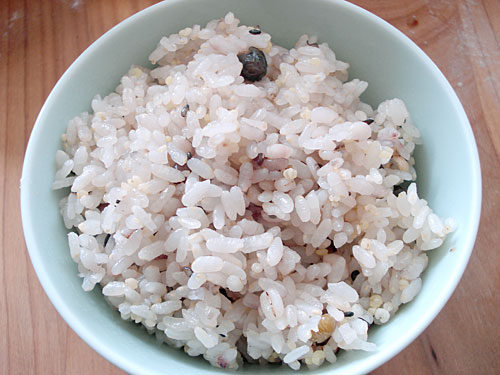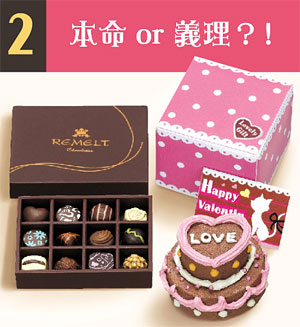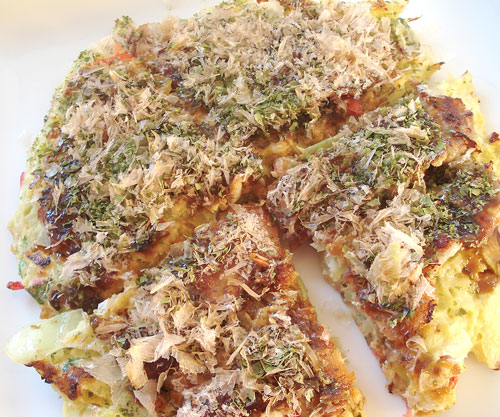
Even if I am Japanese, I don't like all Japanese food. And I must confess that I don't like a lot of traditional Japanese sweets that are based on sweetened beans. For the most part they are way too sweet for me, and if I make them for myself I'm always adjusting the sweetness level, as with my ohagi or botamochi.
Mitarashi dango, however, are my absolute favorite traditional sweet. They are not really that sweet really - that shiny caramel colored sauce (which is called mitarashi sauce) is sweet and savory at the same time. It goes perfectly with the bland, slightly chewy dango or dumplings. (Dango is the name for unfilled solid dumplings.)
You may see the dango just plained boiled more often than not. But grilling the dango makes them so much better, in my opinion.
Filed under:
dessert japanese party food wagashi
[Update:] There seems to be some confusion about how zakkokumai is cooked and looks like, so I've added some more photos and such.

Rice is such an integral part of a Japanese meal, that the word for 'meal' (gohan, ご飯) also means rice. White rice is the norm, both for taste and for various cultural reasons. But as you probably know, white rice (hakumai, 白米) is rice that has been stripped of most of its nutrients, leaving just the starch.
Brown rice (genmai) is the obvious healthier alternative. But brown rice can take some time to cook, what with the soaking and so on that's needed, and some people simply don't like the taste or texture.
In recent years, something called zakkoku-mai (雑穀米)has become increasingly popular in Japan. Zakkoku just means "mixed grains", and mai is rice. Another name for essentially the same thing is kokumotsu gohan (穀物ご飯).
Filed under:
japanese ingredients rice health
 As I wrote about last year, Valentine's Day in Japan is fraught with social stress. Somehow, the chocolate manufacturers have managed to convince the whole society that a girl or woman can't just give chocolates to the ones they love. (And it's only the women who give chocolates in Japan on the 14th, not men, unlike other countries.) She must also give giri choco, or 'obligation chocolates', to people she 'owes'; bosses, teachers, and fathers-in-law.
As I wrote about last year, Valentine's Day in Japan is fraught with social stress. Somehow, the chocolate manufacturers have managed to convince the whole society that a girl or woman can't just give chocolates to the ones they love. (And it's only the women who give chocolates in Japan on the 14th, not men, unlike other countries.) She must also give giri choco, or 'obligation chocolates', to people she 'owes'; bosses, teachers, and fathers-in-law.
Now you can see this kind of social giving in miniature! Re-ment, the maker of amazingly detailed diecast miniatures which I've also written about before, has this set of two types of chocolates: _Honmei or giri?!_ (Your real target, or obligation?!) The caption says this:
Filed under:
chocolate japanese offbeat valentine

Okonomiyaki is getting slowly more popular outside of Japan. It's often described as a Japanese pizza, but it's more like a savory pancake.
Okonomiyaki was invented, they say, in Osaka, which is a city famous for cheap and good eats. Okonomiyaki is a snack more than a full meal, though it is pretty filling. It's a quintessential yatai or streetside food stand food, though nowadays you're more likely to eat it indoors than sitting at an outside stall. It's a very communal type of food, especially if you cook it on a tabletop griddle.
This is a fairly authentic recipe I think, or as authentic as a Tokyo born-and-bred girl can get.
Filed under:
japanese party food
Early last year, a movement to set up an authentification program for Japanese restaurant was proposed, to mixed reactions. Now it seems the people behind it are getting going: the inspectors are already in Bangkok, Shanghai and Taipei, and this year they'll be invading, er researching London, Amsterdam, Los Angeles and Paris.
Filed under:
essays japanese restaurants

I have not featured many fish recipes here on Just Hungry. This is because at the moment I live in a landlocked country, where sea fish must be shipped in, and is expensive to boot. When I do buy some fish, I savor it as a treat. (I may be preparing myself for something that all fish eating people might have to endure soon, given the problems of overfishing.)
This is a classic miso marinade with a spicy twist. Instead of using just miso, I've added a little bit of kochujang, spicy Korean bean paste. I've used cod for this, but you could use any firm, flaky white fish instead - or even an oily fish such as salmon or swordfish. The pieces of fish should have a certain thickness, so thin fish like flounder won't do.
Filed under:
japanese lighter fish
Chocolate. It's such a lovely, malleable substance. It can be shaped into anything really. Anything.
But, one wonders what kind of twisted mind came up with this idea...chocolate truffles shaped like kabutomushi (rhinocerous beetle) larvae!
Avert your eyes if you are squeamish. You may not want to read this while you're eating.
(If you're getting here from the front page, pause and breathe in deeply before clicking that 'continue reading'.
Filed under:
chocolate japanese offbeat
Submitted by maki on 26 January, 2008 - 12:56
Pages